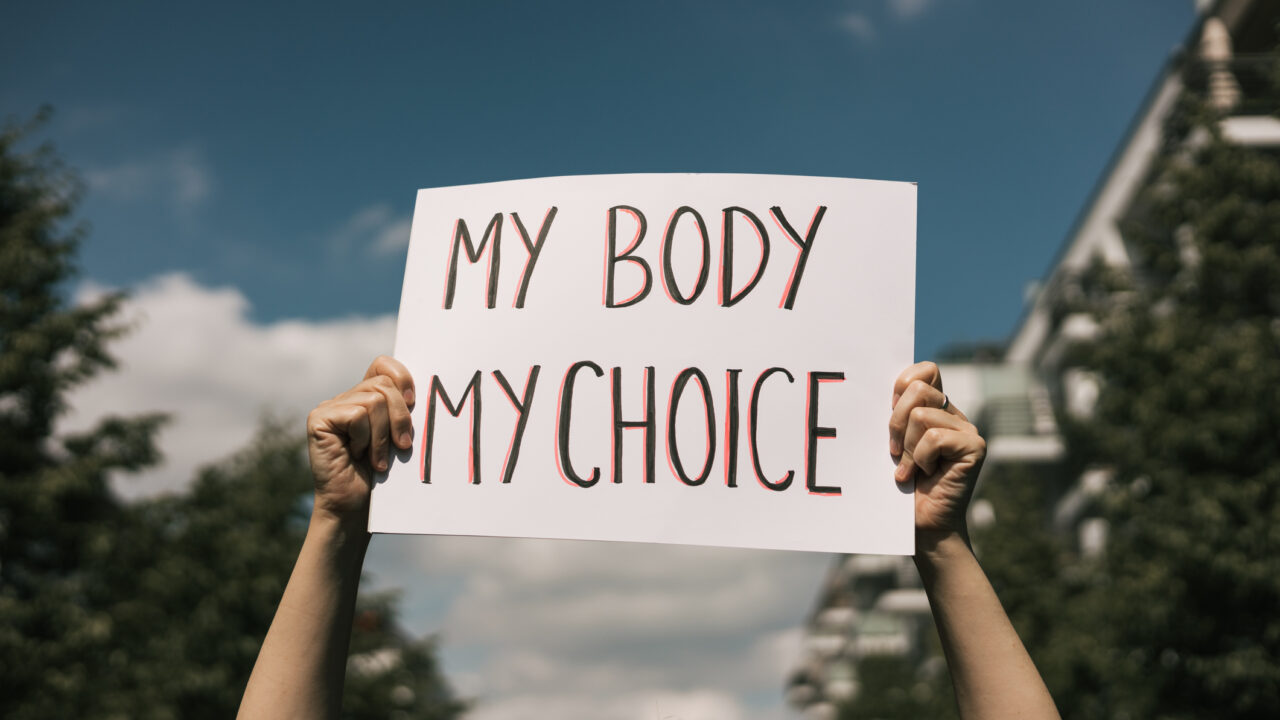Maria Esch, researcher for the Alternative Unionism Project at the Center for Work and Democracy dives deep into the local efforts to pass Proposition 139 in Arizona during the 2024 election.
This article is a part of Left Out: The Missing Election narratives, a collection of unreported histories by publications inside of the Movement Media Alliance.
The Copper State turned red in November 2024.
After swinging blue in 2020, Arizonans sent our Electoral College votes to former President Donald Trump once again. But while Arizonans voted for a candidate who has taken credit for the reversal of Roe v. Wade, we also voted overwhelmingly in support of Proposition 139, the Arizona for Abortion Access ballot initiative. Prop 139 passed with 62% of the vote (417,427 more votes than Vice President Kamala Harris received here) and carried all but two of Arizona’s 15 counties, enshrining the right to provide and receive abortion care in our state constitution.
Six other states also passed measures protecting abortion rights, but Arizona’s expansive win is notable in context of the stressful legal battle here after the Dobbs decision overturned Roe and let states dictate abortion rights.
In April 2024, Arizona Supreme Court justices voted to uphold a near-total, Civil War-era abortion ban. By September, the 1864 law had been repealed by the state legislature, and the state returned to its (still restrictive) 15-week rule on abortion.
For Arizonans, this whiplash between rights and their revocation was sparking more than frustration—people were angry. In the face of the (thankfully never formally implemented) 1864 abortion ban, many people like me were confronted with the reality of a world in which our bodies had become a battleground for political maneuvering without our consent. As the Arizona for Abortion Access Act shifted from an idea to a campaign, I got to hear Arizonans’ feelings around abortion and bodily autonomy directly. During signature collection, voters approached me to make sure their names were down in support; during door knocking, folks showed bravery and vulnerability in telling me their own stories. This campaign experience brought people into policy.
That’s a testament to the care and intentionality of Healthcare Rising Arizona, one of the organizations that launched the campaign. Healthcare Rising is a membership based, nonpartisan organization backed by Service Employees International Union-United Healthcare Workers West that seeks to improve the Arizona healthcare landscape through direct action and legislation. Specifically, it focuses on creating and supporting citizen-driven ballot initiatives to get the job done.

 Healthcare Rising’s wins in the past eight years include an increased minimum wage and a cap on medical debt interest rates in Arizona.When asked about the healthcare landscape in Arizona after the 2022 election (which followed on the heels of Dobbs), Healthcare Rising members cited abortion as a major cause for consternation. In response, the Arizona for Abortion Access Act was born. The strongest possible protection for reproductive rights required a full-blown constitutional amendment, which meant the campaign would need to collect more than 383,923 valid signatures—just to get on the ballot.
Healthcare Rising’s wins in the past eight years include an increased minimum wage and a cap on medical debt interest rates in Arizona.When asked about the healthcare landscape in Arizona after the 2022 election (which followed on the heels of Dobbs), Healthcare Rising members cited abortion as a major cause for consternation. In response, the Arizona for Abortion Access Act was born. The strongest possible protection for reproductive rights required a full-blown constitutional amendment, which meant the campaign would need to collect more than 383,923 valid signatures—just to get on the ballot.
During my tenure at the Center for Work and Democracy at Arizona State University, our team has engaged extensively with the question of whether ballot initiatives are an effective avenue for working-class mobility. A 2022 report from the center, “Majority Rules: The Battle for Ballot Initiatives,” shows that initiatives supporting egalitarian policies— policies that win resources, rights and protections for ordinary people—win more than 60% of the time. Within those egalitarian initiatives, the ones focusing on economic redistribution win a whopping 75% of the time.
Egalitarian policies are popular across red and blue states alike. When it comes down to the raw data untainted by partisanship, Americans overwhelmingly vote to support policies that support them.
As a volunteer organizer for Arizona for Abortion Access, fresh onto the political organizing scene, I was fascinated to see how these data points were put into action during the campaign. From the jump, Healthcare Rising was insistent that organizers for the abortion ballot initiative carry out a nonpartisan campaign. The group’s background data reflected that both Republicans and Democrats were interested in protecting abortion rights in Arizona, and that messaging tied to the Democratic Party would only serve to alienate right-wing voters. Because party alliances don’t always map to policy preferences, Healthcare Rising wanted language and ideas that resonated with people across party lines.
In Arizona, home to Wild West sentiments that frown upon government interference, the angle of messaging was clear: To pass this progressive, pro-choice policy, organizers would have to find common ground between progressive and conservative voters. In the case of abortion, the issues at stake of privacy and individual freedom aligned with Republican skepticism about big government.
When training to collect signatures for the ballot initiative, the organizers in charge—a mix of older women who organized for abortion access in the 1970s and younger women passionate and primed to take on organizing in our current political landscape— wanted us to lean into a few specific talking points. Signature collectors were invited to talk about the potential consequences of an abortion ban in Arizona, yes, but even more so we were encouraged to stress the idea that medical decisions should be between patients and providers, not politicians. We were asked to leave partisan affiliations behind (a number of organizers tried to campaign for Harris while canvassing for 139 and were kindly, but promptly, shut down).
While many of the volunteers had stories of intense confrontation during their efforts collecting signatures in the blistering Arizona heat, my time was surprisingly frictionless. (In fairness, I was primarily posted up in the air conditioning at one of my favorite dive bars in downtown Phoenix.) Not only were folks open to signing my petitions, they were the ones tapping my shoulder to make sure they got the chance to sign. People cited reasons for signing that ranged from “of course women should be able to get abortions” to “my girlfriend would kick my ass if I didn’t sign” to “I don’t want the government to know any of my business.” In short, the messaging that Healthcare Rising proposed was resonating extremely well.
Our signature collection had already been fully underway in April 2024, when the Supreme Court upheld the 1864 ban, and the news of that decision made a big difference. People were flocking in droves to help combat the archaic law, and petition circulators were primed to meet them with consistent, cross-aisle talking points and signature sheets in hand throughout Arizona. (As an Arizona resident, I rarely got through my weekly errands without running into volunteers asking me to sign.
In total, we collected a record 823,685 signatures—meaning roughly one in five Arizona voters signed onto the Arizona for Abortion Access Act before it even hit the ballot. That’s not to say the campaign was easy. Organizers spent countless hours researching and meticulously crafting the language of the proposition before even announcing the campaign. Volunteers of all ages and all across the state spent hundreds of hours standing outside of grocery stores, libraries and local businesses—in temperatures well over 110 degrees—to garner support. Many faced shouts, swears and prayers from opponents of the proposition, but they remained undeterred. When it was finally time to turn in the hundreds of thousands of signatures at the state Capitol, we came face to face with bomb threats, police dogs and opponents insistent on documenting each and every box as it was unloaded and counted. And even after the signatures were turned in, the campaign continued. By late summer, organizers were preparing for the last leg of the campaign: the road to Election Day.
On my first day of canvassing, in October 2024, I was really nervous. Going to new and unfamiliar neighborhoods in the Sun Valley, with its huge and widely dispersed population, is intimidating. There were certainly trials—dogs lunging at us out of open windows while their owners yelled through the storm door for us to go away, gentlemen trying to school us on why we were “so misguided” in our opinions—but, by the end of that day, I felt more invigorated than anything. We were only able to speak with folks at about half of the doors we knocked, and a handful were less than friendly, but the majority of the people we interacted with were comfortable hearing us out and even supportive.
To someone familiar with politics but new to organizing, it was truly a marvel to see how the campaign for Proposition 139 in Arizona translated to success at the polls. While the election night event for 139 was still exceedingly stressful with the results of the presidential election looming in the background, the energy in the room was surprisingly relaxed. Even when that first major drop of votes showed almost two-thirds of voters in support of the Arizona for Abortion Access Act, folks smiled and hugged, but few tears were shed. The moment was big, but no one was shocked.
Between my first time collecting signatures and our last canvassing outing, two days before Election Day, I truly think I was able to reestablish a faith in my broader community. In a society hell-bent on preserving individualism, community connections like talking to your neighbors can sometimes feel like a lost art. But volunteering with Healthcare Rising Arizona and the Arizona for Abortion Access team showed me that finding a friendly face is easier when organizing is approached as relationship building.
This campaign worked because it was never about political maneuvering; it was about coming to the table to talk to people with respect about an issue that impacts so many of us so intimately.

